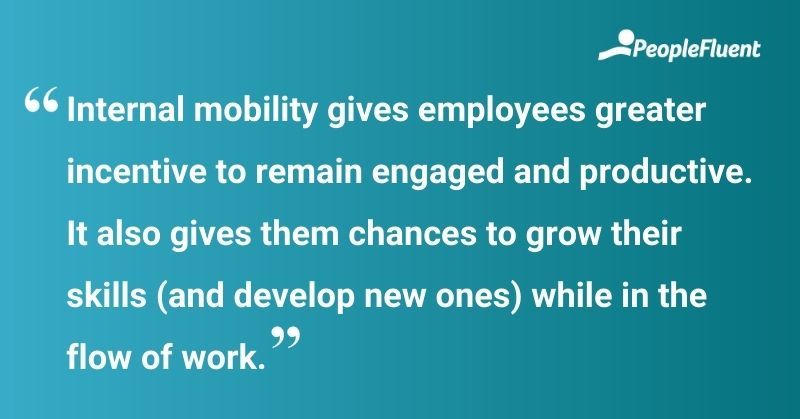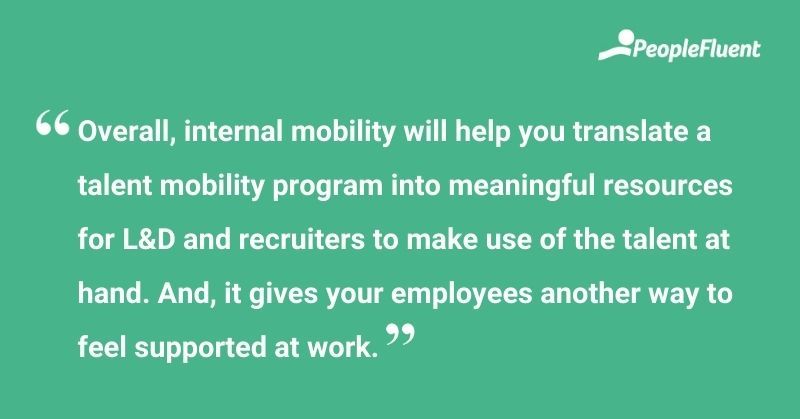Published: Oct 25, 2021Time to read: 5mins Category: Insights
Internal Mobility vs Talent Mobility: What’s the Difference and Why It Matters
People are increasingly identifying their purpose in life and work. They’re making every attempt to balance their on-the-job responsibilities with passions, interests, and abilities. If your company culture won’t allow for both personal and career growth, talent will go elsewhere. In fact, a study shows that there’s a 76% chance that an employee will stay with an organization after their first year, with retention dropping to just 38% after five years. A talent mobility program (along with the tech to mobilize employees within the business) can help people navigate their careers and meet mission-critical tasks.
Internal mobility—a function of a talent mobility program—gives employers the tools to help employees create personalized career paths. These paths can and should be tied to business outcomes, allowing your people to grow their abilities, competencies, and potential. Ultimately, it helps businesses meet and exceed goals as internal mobility will drive greater levels of employee retention, engagement, and productivity.
Below, we’ll take a closer look at:
- What internal mobility is and how it helps your organization
- How talent mobility and internal mobility are different
- Why you need talent mobility tech that helps you mobilize internal talent
Let’s get started with a quick overview of what internal mobility is.
What Is Internal Mobility?
Internal mobility is the movement of employees to new roles or opportunities within the same business. These opportunities typically include new positions, stretch projects, and/or mentorships. Internal mobility has several advantages:
- For the business, it provides coverage for important tasks or projects that allow the organization to flex when needed and operate smoothly.
- On the employee side, internal mobility gives employees greater incentive to remain engaged and productive. It also gives them chances to grow their skills (and develop new ones) while in the flow of work.

KEEP READING | ‘3 Ways AI Can Drive Internal Mobility at Your Organization’
What Is Talent Mobility?
Talent mobility gives your company the ability to understand the skills, experiences, and career interests of your employees. The overarching goal of this is to move employees into new roles internally, where existing skills can be sharpened and new skills can be developed. While talent mobility is the vehicle that makes internal mobility possible, internal job matching is just one aspect of a talent mobility program.
You can read more about what talent mobility is, plus what it’s not, here.
What’s the Difference Between Internal Mobility and Talent Mobility?
Imagine you move to a new country and you’re given a map to help you get around. Much to your dismay, the map is in a language you don’t speak or understand. Unfortunately, the only way you can find help navigating is with the map.
So, you’re basically stuck at the starting point—in a new place with no visibility into where you can find help. Surely this is an anxiety-inducing situation for any of us who’ve dealt with language barriers or even those of us who may not know where to find answers to our pressing issues.
Without an internal mobility plan in place, this could be exactly how your employees are feeling. Left without a means to navigate their career paths, they might feel hopeless or as if they can’t excel within your organization. Similarly, recruiters and hiring managers may be struggling to overcome skills and organizational gaps due to a lack of visibility.
Talent mobility gives both employees and employers a way to translate these issues into solutions by:
- Helping you develop a strategy that empowers employees to grow their careers
- Providing you with the tools to make sense of where talent exists, how it can be mobilized, and which gaps it will help fill

YOU MIGHT ALSO LIKE | ‘The 5 Pillars of a Successful Talent Mobility Strategy and How to Leverage Them’
Why It Matters in Today’s Workplace
The world of work has changed, and skills gaps will be felt across organizations for years to come. This gives learning and development teams a unique opportunity to put upskilling and reskilling into practice. After all, moving talent from one part of the business to another requires new skills and competencies to ensure the employee is successful in the new role or project. Internal mobility will deepen the workforce insights you already have, allowing you to reach another important destination: the development of new L&D programs.
Before any of this can happen, leaders must identify where employees are and where their skills need to be—the first step in creating L&D programs to nurture, grow, and develop existing talent. Empowering employees to engage with growth opportunities is easier when they feel supported and incentivized.
In past years, learning new skills may not have been enough of an incentive for employees to engage with internal mobility efforts. However, 59% of L&D pros have ranked reskilling and upskilling as a top priority for 2021. And, the same research found that Gen Zers are highly motivated to grow their careers, with 76% seeing learning as the key to their advancement.
Creating an internal gig culture will give employees a way to find priority projects that align with their ongoing career development and simultaneously benefit business needs. This means recruiters will need to take a proactive approach to internal recruitment—a task that becomes easier by having an internal mobility plan in place.
Internal mobility also:
- Gives recruiters greater visibility into who’s viewing posted jobs or opportunities
- Helps empower recruiters to push job recommendations to employees based on skills and interest
- Allows employees to see internal jobs based on their career interests, skills, and experience
Overall, internal mobility will help you translate a talent mobility program into meaningful resources for L&D and recruiters to make use of the talent at hand. And, it gives your employees another way to feel supported at work.

RELATED READING | ‘Upskilling vs. Reskilling: Understanding the Differences and Their Role in Talent Mobility’
Are you ready to engage your top talent with an internal mobility program?
The greater your visibility, the better your internal mobility program will be. To get the conversation started, reach out to our talent mobility experts. We can help you identify opportunities to upskill, reskill, and mobilize your workforce.